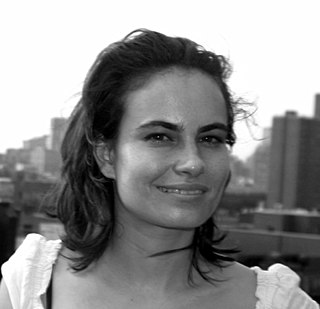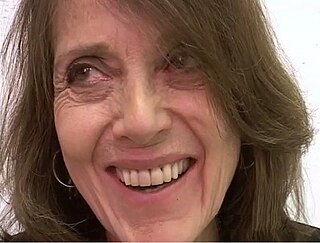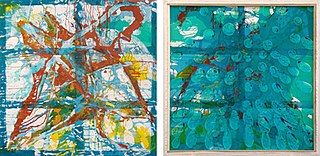
Inka Essenhigh is an American painter based in New York City. Throughout her career, Essenhigh has had solo exhibitions at galleries such as Deitch Projects, Mary Boone Gallery, 303 Gallery, Stefan Stux Gallery, and Jacob Lewis Gallery in New York, Kotaro Nukaga, Tomio Koyama Gallery in Tokyo, and Il Capricorno in Venice.
Walter Darby Bannard was an American abstract painter and professor of art and art history at the University of Miami.

Pat Lipsky is an American painter associated with Lyrical Abstraction and Color Field Painting.

Cora Cohen was an American artist whose works include paintings, drawings, photographs, and altered x-rays. Cohen is most known for her abstract paintings and is often identified as continuing the tradition of American Abstraction. In a 2023 review in Artforum Barry Schwabsky suggested that "Cohen’s determination to evade stylistic consistency has made her one of the most underrated painters in New York." The New York Times' critic Michael Brenson wrote of her 1984 exhibition, Portraits of Women: "The works are dense, brooding and yet elated. The turbulence of the paint not only looks but also feels like freedom." Cohen interviewed many other artists also associated with continuing the tradition of American Abstraction for Bomb Magazine including; Ralph Humphrey, Dona Nelson, Craig Fisher, Carl Ostendarp, and Joan Mitchell. Her work has also been identified with traditions of European abstraction, and specifically German abstraction, including the work of Wols, Sigmar Polke, Gerhard Richter. She began exhibiting in Germany in the early nineties and continued to show at some of its most prestigious institutions.

Jessica Stockholder is a Canadian-American artist known for site-specific installation works and sculptures that are often described as "paintings in space." She came to prominence in the early 1990s with monumental works that challenged boundaries between artwork and display environment as well as between pictorial and physical experience. Her art often presents a "barrage" of bold colors, textures and everyday objects, incorporating floors, walls and ceilings and sometimes spilling out of exhibition sites. Critics suggest that her work is informed by diverse artistic traditions, including abstract expressionism, color field painting, minimalism and Pop art. Since her early career, they have noted in her work an openness to spontaneity, accident and marginality and a rejection of permanency, monetization and disciplinary conventions that Stephen Westfall characterized as an "almost shocking sense of freedom."
Stephen Westfall is an American painter, critic, and professor at Rutgers University and Bard College.
Harmony Hammond is an American artist, activist, curator, and writer. She was a prominent figure in the founding of the feminist art movement in 1970s New York.

Thornton Willis is an American abstract painter. He has contributed to the New York School of painting since the late 1960s. Viewed as a member of the Third Generation of American Abstract Expressionists, his work is associated with Abstract Expressionism, Lyrical Abstraction, Process Art, Postminimalism, Bio-morphic Cubism and Color Field painting.
Amy Feldman is an American abstract painter from Brooklyn, New York.

Polly E. Apfelbaum is an American contemporary visual artist, who is primarily known for her colorful drawings, sculptures, and fabric floor pieces, which she refers to as "fallen paintings". She currently lives and works in New York City, New York.
Moira Dryer (1957–1992) was a Canadian artist known for her abstract paintings on wood panel.
Joan Nelson is a visual artist who lives and works in upstate New York. For over three decades, Nelson has been making "epic and theatrical landscape paintings," borrowing from art history and re-presenting iconic vistas from the Fine Art lexicon including those of the Hudson River and Mount Hood.
Kim McCarty is an artist and watercolor painter living and working in Los Angeles, California. Her work has been exhibited in over twenty solo exhibitions in New York and Los Angeles. She often works in large formats using layers of monochromatic colors.

Dona Nelson is an American painter, best known for immersive, gestural, primarily abstract works employing unorthodox materials, processes and formats to disrupt conventional notions of painting and viewership. A 2014 New Yorker review observed, "Nelson gives notice that she will do anything, short of burning down her house to bully painting into freshly spluttering eloquence." Since 2002, long before it became a more common practice, Nelson has produced free-standing, double-sided paintings that create a more complex, conscious viewing experience. According to New York Times critic Roberta Smith, Nelson has dodged the burden of a "superficially consistent style," sustained by "an adventuresome emphasis on materials" and an athletic approach to process that builds on the work of Jackson Pollock. Writers in Art in America and Artforum credit her experimentation with influencing a younger generation of painters exploring unconventional techniques with renewed interest. Discussing one of Nelson's visceral, process-driven works, curator Klaus Kertess wrote, the paint-soaked "muslin is at once the tool, the medium, and the made."
Paul Henry Ramirez is an American contemporary artist known for his biomorphic abstractionist paintings. As his figural based paintings evolved to include geometrics, in 2010, Ramirez coined the term "biogeomorphic abstraction" to describe his own bold painting style, a fusion of biomorphic and geometric forms. He also gained notability for his site-specific installations as his paintings began to expand outside the confines of the canvas edges onto the walls of the gallery space. These site-specific installations gradually evolved to encompass the whole gallery space, creating a full environmental experience. Donald Kuspit, scholar and art critic, describes Ramirez as “an important new kind of abstract painter. .. an abstractionist playing with color and form to exciting imaginative effect.”

Leslie Wayne is a visual artist who lives and works in New York. Wayne is best known for her "highly dimensional paintings".

Laurie Fendrich is an American artist, writer and educator based in New York City, best known for geometric abstract paintings that balance playfulness and sophistication. Her work has been featured in solo exhibitions in New York, Los Angeles and Chicago, a retrospective at the Williamson Gallery at Scripps College (2010), and group shows at MoMA PS1, the Los Angeles County Museum of Art, and the National Academy of Design, among many venues. She has received reviews in publications including The New York Times, Artforum, Art in America, Arts Magazine, ARTnewsPartisan Review, and New York Magazine. Fendrich has been awarded fellowships from the Guggenheim Foundation (2016), Brown Foundation at the Museum of Fine Arts, Houston, and National Endowment for the Arts (1983–4). She has been an educator for more than four decades, notably at Hofstra University (1989–2014), and a regular essayist for The Chronicle Review at The Chronicle of Higher Education.
Caitlin Cherry is an African-American painter, sculptor, and educator.

Harriet Korman is an American abstract painter based in New York City, who first gained attention in the early 1970s. She is known for work that embraces improvisation and experimentation within a framework of self-imposed limitations that include simplicity of means, purity of color, and a strict rejection of allusion, illusion, naturalistic light and space, or other translations of reality. Writer John Yau describes Korman as "a pure abstract artist, one who doesn’t rely on a visual hook, cultural association, or anything that smacks of essentialization or the spiritual," a position he suggests few post-Warhol painters have taken. While Korman's work may suggest early twentieth-century abstraction, critics such as Roberta Smith locate its roots among a cohort of early-1970s women artists who sought to reinvent painting using strategies from Process Art, then most associated with sculpture, installation art and performance. Since the 1990s, critics and curators have championed this early work as unjustifiably neglected by a male-dominated 1970s art market and deserving of rediscovery.
James Little is an American painter and curator. He is known for his works of geometric abstraction which are often imbued with exuberant color. He has been based in New York City.










